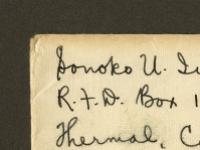Through an examination of the documents, students will gain a greater understanding of the hostility immigrant groups faced socially and politically in the United States. The lesson focuses on the arguments against immigration in the 18th, 19th, and 20th centuries.
Immigration in the American Tradition, 1727 to 1942
Immigration in the American Tradition, 1727 to 1942
Essential Questions
Objectives
• Students will be able to describe the fears people had of newly arriving groups of immigrants.
• Students will be able to trace the central themes against immigration from its origins in the late eighteenth through twentieth centuries.
• Students will be able to compare and cite examples from the documents against immigration to North America.
• Students will be able to summarize the complex relationship between the Iwata family and the United States.
Other Materials
Suggested Instructional Procedures
Primary Sources
- Memorial against Non-English Immigrants, December 1727
- Certificate of Vote on "An Act to Ascertain and Express the Will of the People of the State on California on the Subject of Chinese Immigration," 1879
- Selected Shigezo and Sonoko Iwata Correspondence, May 28-July 22, 1942
Process
1. Introduce the subject of immigration and xenophobia. Review the various ethnic groups who migrated to the United States (include major names, events, and vocabulary words).
2. Have the students take notes on the author, year, title, and possible audience for each document.
3. Assign the readings either as homework or in class.
4. Listed below are a few questions that maybe used as review of reading comprehension, to lead student-based discussions, or be incorporated into an essay.
- Compare the arguments made in 1727 and 1879. What similarities did the settlers and later people of California share? Why? Explain.
- Contrast the Chinese Immigration Restriction document and the letters of the Iwata family. How do these documents illustrate two different sides of the immigrant experience? Explain.
- To what extent are both the Memorial against Non-English Immigrants and the Iwata letters similar appeals to their respective governments? What reasons did the authors have to seek government intervention? Explain.
- How do the views expressed in the documents reflect the uncertainty of the times in which the authors / groups lived? What global events contributed to the rise in xenophobia during the years of 1727, 1879, and 1942? Explain.
5. Conclude the period with an informal question and answer session on any comments or concerns raised during the lesson.
Vocabulary
The unit and lesson plan complement Preserving American Freedom, featuring fifty of the treasured documents within the vast catalog of the Historical Society of Pennsylvania. The documents read online will contain annotations that define and explain many key terms, figures, and organizations.
Xenophobia: Fear of people who seem different or strange, such as other ethnic groups.
Related Resources for Students
Plans in this Unit
Grade Level
Duration
Standards/Eligible Content
Funder
The Freedom Teacher Fellow was funded through a Bank of America grant for the digital history project Preserving American Freedom.
About the Author
This unit was created by David Reader, HSP's Freedom Teacher Fellow in the summer of 2012. David is a social studies teacher at Camden Catholic High School.
Attention Teachers!
Let us know how you used this plan and be featured on our site! Submit your story here.


